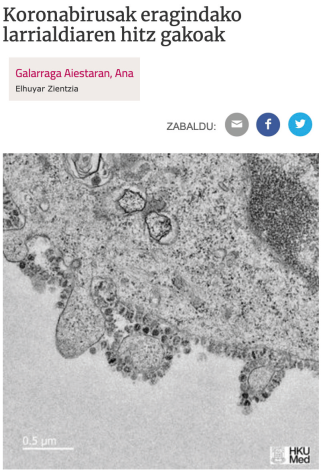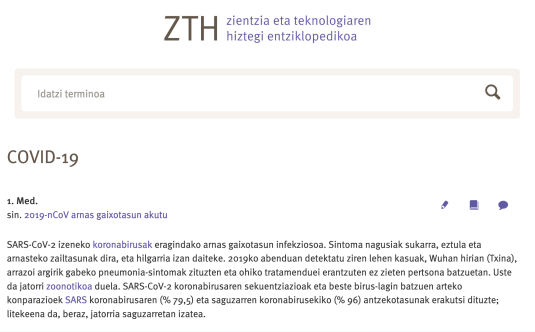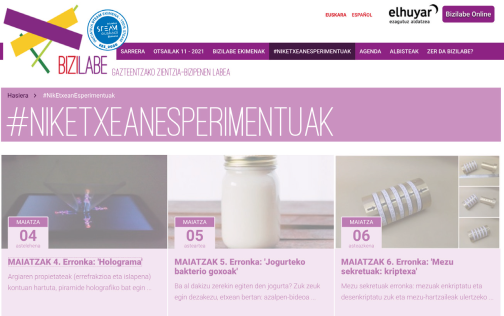They say that the pot is tested on fire and that the fire that ignites a virus called SARS-CoV-2 has not been any. It was not easy to have a good pot, but since its creation Elhuyar has aimed to disseminate scientific culture, in order to contribute to the construction of a critical and judicious society. Thus, his trajectory, year after year, in collaboration with society, has allowed him to put a solid pot and dress, but with humility, prudence, responsibility and scientific evidence.
This has been the compass that Elhuyar has guided in the communication of the COVID-19 crisis: the scientific evidence. In February 2020, when the virus SARS-CoV-2 was still a distant problem in Europe, the World Health Organization named as infodemia the information generated by the World Health Organization about this new virus. At that time, the concern of the WHO was that the continuous flow of information could generate excessive alarm in society. In fact, it did not believe that there was a significant risk of expansion outside China or that it caused serious damage.
Soon after, the forecasts were too optimistic. It was time to set the pot on fire. Elhuyar had two clear responsibilities: on the one hand, to explain the essence of what was happening and, on the other, to give in Basque the names of each of the viruses and diseases that until then did not exist, and some concepts related to them, unknown.

Science, comprehensible and in Basque
Thus, the journal Elhuyar published on February 3, 2020 the article entitled “Keywords of the coronavirus emergency”, and used the spaces of collaboration in other media to explain its meaning: coronavirus, zoonosis, pandemic, international emergency, rate and lethality, R0 and antiviral number.
While the magazine had previously published some news about “Wuhan pneumonia” (the name they gave it at the beginning), this was, in some way, the first stone of Elhuyar’s communication in the syndemia era. All subsequent work has been built on ways to make Elhuyar and her commitment to society.
Precisely, the members of scientific communication and vocabulary collaborated from the very beginning to offer society accurate, current and correct information, both from the scientific and terminological point of view. The Encyclopedic Dictionary of Science and Technology of Elhuyar renewed the entry of coronavirus and created COVID-19 and launched the section "Elhuyar Recommendations", especially to clarify doubts about the meaning and use of new concepts related to syndemia.

The explanation of the virus and its consequences has been more complex and complex than the resolution of doubts about language. And that is that citizenship wanted clear answers through round-lines. And it"s not because the scientific method needs questions and evidence to provide answers, and it takes time.
As evidence is obtained, assumptions are confirmed or annulled and, in the latter case, it may be the case that some citizens take information with suspicion ("the opposite of what I said earlier is now being said"). Therefore, understanding how scientific knowledge is constructed has been key to achieving credibility.
Inconsistency
In health crises, the credibility of the information received by citizens is essential, not only to adapt to reality, but to rigorously comply with the preventive measures adopted: the better the cause of the measures is understood and their benefit, the greater the adherence to them.
In the COVID-19 crisis, although similar measures have been implemented in most countries to curb the plague (border closures, confinements, prohibition of concentrated activities, physical distance, masks, hygiene…), the results have been very different. According to international studies, noise has had a direct influence not only on management factors, but also on communication at level. In this sense, New Zealand has been taken as a model, highlighting the empathic leadership, the direct, clear and coherent message, well reasoned, and the active sense of active participation of citizens.
Other places have not acted in the same way. For example, the differences between the authorities’ messages and the advice of scientists have been significant, which has led to doubts among the population about the appropriateness of measures. In this sense, the communication directed by Elhuyar has always been based on scientific evidence and it cannot be denied that sometimes the institutional norms and messages have not contributed to that information reaching society in a clear and consistent manner.
Two significant examples can be cited: masks and aerosols. Other airborne diseases had already demonstrated the effectiveness of masks to prevent transmission. Studies were started to measure the effectiveness against the SARS-CoV-2 virus and while results were obtained, some countries (especially in Asia) cautiously encouraged the use of masks and others not (including Europeans).
Previous experiences with other pathogens and cultural habits also conditioned in part the attitude of both: In many Asian countries SARS and MERS pests were well remembered, and masks are not rare, while in Europe it is the 21st. At the beginning of the century, a plague remained in a state of threat, without special measures, and there is no habit of wearing masks. In addition, there were no masks in Europe, neither for health workers and caregivers.
One possible solution could be to teach how to do at home to deal with the lack of masks. However, that path was not followed. Authorities stated that masks were not necessary, contrary to what scientists suggested. This has made it difficult to approve the dress order when there were already enough masks. However, evidence shows what scientists suggest: masks, along with other measures, are essential to avoid transmission.

The same has happened with transmission by aerosols, which the authorities have not taken into account, despite the fact that many scientists have been warning of the danger of being in closed and poorly ventilated places, where viruses accumulate in the air and could reach remote places. Some judges have made the difference of opinion between authorities and scientists more evident.
It is clear that the fact that the messages disseminated through official channels do not correspond to those of scientists makes it difficult to transmit clear and coherent information to the public. To overcome this difficulty, the members of Elhuyar in the field of socialization of science have worked continuously from two values: security and transparency.
Another obstacle to the dissemination of science-based information has been laziness and deniationist messages. When fear and uncertainty take hold, they rush and power, and in the COVID-19 era, social media has served to spread their message. These networks are ideal for creating permeable eco bubbles.
Close to receptors
Of course, social networks also serve to give greater impact to quality information and, in particular, to those who do not have the habit of using traditional media. They also serve to understand people’s concerns and doubts, as well as to be able to participate in direct poliation with other experts or with any interested person. In addition to corporate accounts, Elhuyar members have made use of personal accounts in expoliation.
The network has also made it possible to meet the needs of recipients of other age groups. At the time of confinement, when students had the classes closed, they had the opportunity to perform scientific experiments at home, thanks to the material developed by Elhuyar"s STEAM Education. In particular, Bizilabe created a calendar of “Experiments of #NiComes” to work scientific concepts in a simple and entertaining way in the family.

In any case, the most productive way to achieve this close relationship with the recipients has been the media in Basque. At the dawn of the crisis, Elhuyar contributed to the dissemination of video films produced. In view of the reception they had, there is no doubt that the recipients really appreciated the project. Later, this path has been maintained through the Teknopolis section “The Keys to the Coronavirus”. Finally, 40 media outlets in Basque have collaborated to bring the information produced in all formats closer to the recipients.

Fast and deep
In order to respond as quickly and appropriately as possible to the present day, these short videos, as well as the columns, interviews and analyses published in collaboration with other media.
Along with them, Elhuyar has also worked with long-inspired content through his projects, such as Elhuyar magazine. Given that the COVID-19 crisis is a synonym, together with experts in the different areas in which it intersects (microbiologists, epidemiologists, pharmacists, pediatricians, legal and ethical experts, sociologists, ecologists, economists…), attempts have been made to explain the key to it. The recipients are grateful, once again, to address the issue from different angles and to work in depth. In fact, in 2020 the ten most read contents of the journal, except two, refer to COVID-19, variables to be taken into account in the transmission of the virus, the report «COVID-19 in the long term», the interview with public health doctor Amaia Bacigvc de la Hera, the ethical issue of vaccinations…
The pot is tested on fire and it has been shown that the best is the pot worked over time and that which has been consolidated in the community. At a time when the importance of social diffusion of scientific culture has become apparent, Elhuyar and the Basque media have managed to merge for the benefit of society as a whole. Let it go far, the path that has now been taken.


